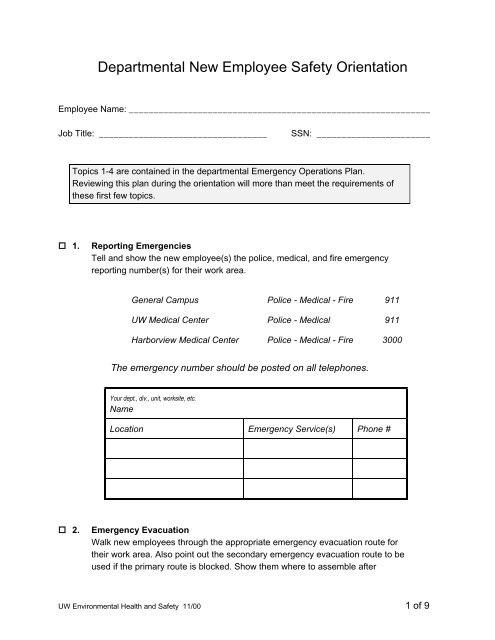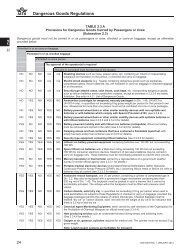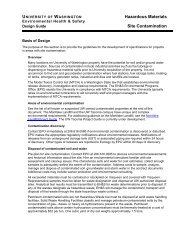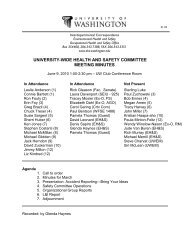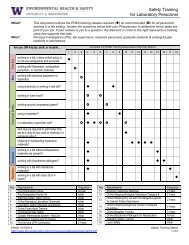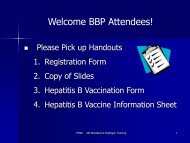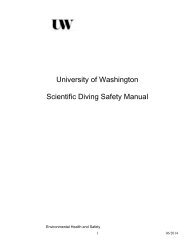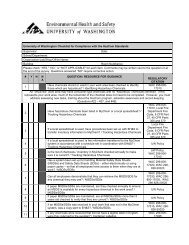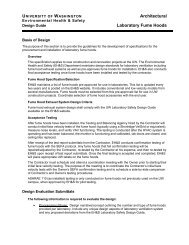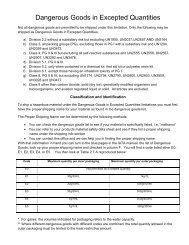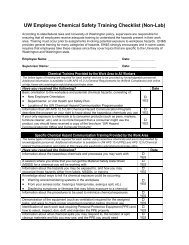Departmental New Employee Safety Orientation - Environmental ...
Departmental New Employee Safety Orientation - Environmental ...
Departmental New Employee Safety Orientation - Environmental ...
- No tags were found...
Create successful ePaper yourself
Turn your PDF publications into a flip-book with our unique Google optimized e-Paper software.
<strong>Departmental</strong> <strong>New</strong> <strong>Employee</strong> <strong>Safety</strong> <strong>Orientation</strong><strong>Employee</strong> Name: _____________________________________________________________Job Title: __________________________________SSN: _______________________Topics 1-4 are contained in the departmental Emergency Operations Plan.Reviewing this plan during the orientation will more than meet the requirements ofthese first few topics. 1. Reporting EmergenciesTell and show the new employee(s) the police, medical, and fire emergencyreporting number(s) for their work area.General Campus Police - Medical - Fire 911UW Medical Center Police - Medical 911Harborview Medical Center Police - Medical - Fire 3000The emergency number should be posted on all telephones.Your dept., div., unit, worksite, etc.NameLocation Emergency Service(s) Phone # 2.Emergency EvacuationWalk new employees through the appropriate emergency evacuation route fortheir work area. Also point out the secondary emergency evacuation route to beused if the primary route is blocked. Show them where to assemble afterUW <strong>Environmental</strong> Health and <strong>Safety</strong> 11/00 1 of 9
<strong>New</strong> <strong>Employee</strong> <strong>Safety</strong> <strong>Orientation</strong> ChecklistUsually their supervisor a. Reporting Accidents and IncidentsExplain that after they immediately report on-the-job accidents, they haveto fill out a University accident incident report form.Work LocationFormUniversity UoW 1428UW Medical CenterHarborview Medical CenterUH0266UH0266Dental School UoW 1119Your report formnameReport form #Request form fromExplain the form and tell them where the forms are located. All accidents ornear accidents (incidents) must be reported on this form even if nopersonal injury was sustained.Reporting all accidents and incidents helps the University and theemploying departments initiate effective safety programs and accidentprevention measures. b. Reporting Motor Vehicle AccidentsAll automobile accidents in University-owned vehicles must also bereported to the University Police Department (911) immediately, whether ornot there appears to be personal injury or property damage. c. Reporting Unsafe Conditions and ActsAlong with immediately reporting unsafe conditions and acts to theirsupervisors or the person noted above, employees may report safetyproblems to <strong>Environmental</strong> Health and <strong>Safety</strong>.Explain that employees should take responsibility for correcting unsafe<strong>Environmental</strong> Health and <strong>Safety</strong> 11/00 3 of 9
<strong>New</strong> <strong>Employee</strong> <strong>Safety</strong> <strong>Orientation</strong> Checklistconditions when feasible, e.g., wiping up small, nontoxic spills andremoving tripping hazards. 6.Workers’ Compensation and Industrial InsuranceTell employees that work-related injuries or illnesses resulting in medicalexpenses or time loss are covered by Washington State’s Workers’Compensation. To establish a Workers’ Compensation claim, employees mustfill out a State Department of Labor and Industries (L&I) Report of IndustrialInjury or Occupational Disease at their medical provider’s office when theyreceive medical care for a work-related injury or illness. Explain, also, thatprompt reporting of accidents to you, the supervisor, will make the claimsprocess easier and may allow you to find them modified work during theirrecovery. 7.First AidTell new employees where first aid kits are located. If your department isrequired to have first aid certified employees on staff, (UW OPS D 10.5) tell newemployees who they are and how to contact them. Explain what actionsemployees should take if they or others are injured. If safety showers or eyewash stations are located in your department, show new employees where theyare and instruct them in their use. 8.Hazard Communication (Chemical <strong>Safety</strong>) (Worker Right-to-Know, HazCom) a. General (all employees)• Tell new employees where hazardous materials are used or stored intheir work area.• Explain the labeling system for these materials.• Show employees where material safety data sheets (MSDSs) arelocated or explain how they can obtain an MSDS.• If new employees will be working with hazardous materials, tell themthey will receive training in the safe handling of these materials orconduct the training at this time, if appropriate.<strong>Environmental</strong> Health and <strong>Safety</strong> 11/00 4 of 9
<strong>New</strong> <strong>Employee</strong> <strong>Safety</strong> <strong>Orientation</strong> ChecklistHazard Communication training is conducted by supervisors or adesignated departmental trainer.• Inform new employees that hazardous materials emergencies, such asspills or releases too big for them to clean up, are to be reported to:WhoPhoneSmall SpillsLarge Spills or releasesReport large spills or releases to (General Campus 911)(UW Medical Center 911)(Harborview Medical Center 3000)(Department protocol for off campuslocations)• Explain the hazardous materials waste disposal procedures that applyin your area. b. Specific WorksitesOffice StaffFor staff whose only chemical exposures are in an office environment,• Provide a copy of the brochure "UW Hazard Communication forOffice and Computer Products.”• Discuss hazard information and protection measures for productsthey will work with.• Explain an MSDS and tell employees where they are located orhow to obtain them.Laboratory StaffLaboratory staff may be sent to the EH&S course "Chemical <strong>Safety</strong> inthe Laboratory" for an introduction to chemical safety regulations andprocedures. The laboratory supervisor or principal investigator mustprovide additional training, specific to the chemicals in the laboratory.See the UW Laboratory <strong>Safety</strong> Manual (5/00 rev.), Section 7 <strong>Safety</strong>Training.<strong>Environmental</strong> Health and <strong>Safety</strong> 11/00 5 of 9
<strong>New</strong> <strong>Employee</strong> <strong>Safety</strong> <strong>Orientation</strong> ChecklistNon-Laboratory Hazardous Chemicals<strong>Employee</strong>s who work with chemicals in non laboratory environmentsmust receive detailed hazard communication training from theirsupervisor or designated departmental HazCom trainer. (<strong>Employee</strong>swho fall into this category include maintenance,custodial/housekeeping, food service and printing andcopy/duplicating employees.) 9.Worksite Warning Signs and LabelsExplain to all new employees the meaning of warning signs, tags, and labelsused in their work area. 10. Personal Protective Equipment (PPE)Check the personal protective equipment needed for this job.Gloves<strong>Safety</strong> Glasses, Goggles,Face ShieldsPersonal Protective ClothingOrange <strong>Safety</strong> VestHard HatsHearing ProtectorsFall Protection<strong>Safety</strong> ShoesRespiratorExplain precisely the use, care, cleaning, and storage of any personal protectiveequipment the new employee will be required to use on the job. Stress the needfor strict adherence to department, division, unit, and/or lab policy on the use ofPPE. 11. <strong>Employee</strong> <strong>Safety</strong> and Health TrainingUse the following list to indicate the safety and health training classes the newemployee will be required to take for their job. Recommended classes couldalso be marked but priority must be given to arranging the required health andsafety training classes.• Please register new employees in EH&S courses as soon as youare aware of their start date since many required courses fill<strong>Environmental</strong> Health and <strong>Safety</strong> 11/00 6 of 9
<strong>New</strong> <strong>Employee</strong> <strong>Safety</strong> <strong>Orientation</strong> Checklistearly.<strong>Environmental</strong> Health and <strong>Safety</strong> courses are general and must oftenbe supplemented with specific training by the department orsupervisor.<strong>Environmental</strong> Health and <strong>Safety</strong> 11/00 7 of 9
<strong>New</strong> <strong>Employee</strong> <strong>Safety</strong> <strong>Orientation</strong> Checklist<strong>Employee</strong> <strong>Safety</strong> and Health Training Check ListMark training/courses the employee needs to take. Retain documents verifying that the trainingrequirements have been met.Course Provided by Course Provided byALL NEW DEPARTMENT EMPLOYEESGeneral <strong>Orientation</strong> T&D <strong>Departmental</strong>/Supervisor <strong>New</strong><strong>Employee</strong> <strong>Orientation</strong>DepartmentCampus <strong>New</strong> <strong>Employee</strong><strong>Orientation</strong>T&DHazard Communication (WorkerRight to Know)Department<strong>New</strong> <strong>Employee</strong> Benefits<strong>Orientation</strong>BenefitsOfficeAS REQUIRED BY JOBAsbestos Awareness EH&S Laboratory Fire <strong>Safety</strong> EH&SBloodborne Pathogen ExposureControlChemical <strong>Safety</strong> in theLaboratoryEH&S MyChem EH&SEH&S Lead Awareness EH&SChemical Spills Clean-up EH&S Lifting Training - Back ProtectionProgramChemical Waste Disposal EH&S Lockout <strong>Safety</strong> - (EnergyControl)Confined Space Entry EH&S Motorized/Powered PersonnelLiftsEH&SEH&SMfg/SupplierCompressed Gas <strong>Safety</strong> EH&S Office Ergonomics EH&SCPR EH&S Powder Activated Tools Mfg/SupplierFire Extinguisher Training EH&S Radiation <strong>Safety</strong> Training EH&SFirst Aid / CPR EH&S Respiratory Protection and MaskFittingEH&SForklift Operator <strong>Safety</strong>CertificationEH&S Scaffolds Mfg/SupplierHearing (Protection)ConservationEH&SOTHER DEPARTMENTAL REQUIRED / RECOMMENDED COURSESShipping and TransportingHazardous MaterialsTraffic Control and FlaggingEH&SOutsideagent<strong>Environmental</strong> Health and <strong>Safety</strong> 11/00 8 of 9
<strong>New</strong> <strong>Employee</strong> <strong>Safety</strong> <strong>Orientation</strong> Checklist 12.<strong>Safety</strong> and Health Committee(s) and/or <strong>Safety</strong> MeetingsTell new employees about the Organizational and University-wide Health and<strong>Safety</strong> Committees and about the departmental health and safety committeeand safety meetings, if applicable. Tell them who their safety committeerepresentatives are and how to contact them. 13. <strong>Safety</strong> Bulletin BoardPoint out the departmental safety bulletin board and tell them what items can befound on the board.The bulletin board must display the following posters:-• UW HazCom Poster• State Labor and Industries Posters"Job <strong>Safety</strong> and Health Protection""Notice to <strong>Employee</strong>s""Your Rights as a Worker"• Other safety notices, newsletters, safety and health committee minutes, etc.should be posted here also. 14. <strong>Departmental</strong>/Worksite <strong>Safety</strong> Practices and RulesConduct an on-the-job review of the practices necessary to perform the initialjob assignments in a safe manner. <strong>Employee</strong>s should understand thatsupervisors will provide job safety instruction and inspection on a continuingbasis. Review safety rules for your department (e.g., non-smoking areas,working alone, safe use of chemicals, biohazards, radioactive materials, etc). 15. Tour Department/Facility Reviewing Worksite HazardsEncourage your employees to ask questions and to develop a sense of safetyconsciousness.<strong>Environmental</strong> Health and <strong>Safety</strong> 11/00 9 of 9


